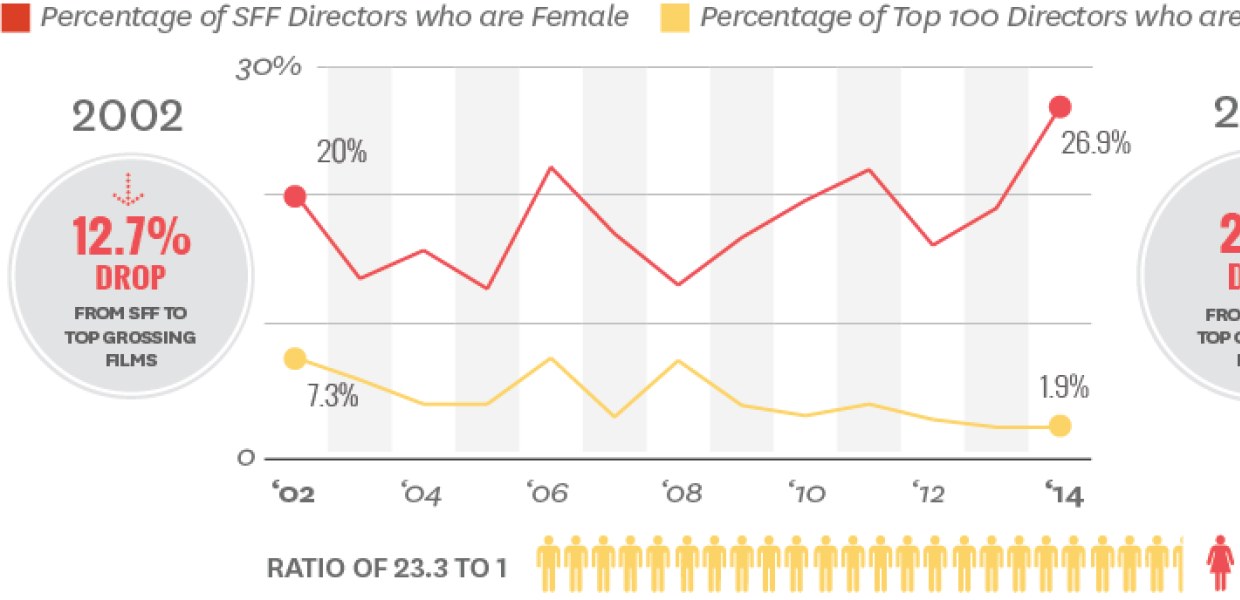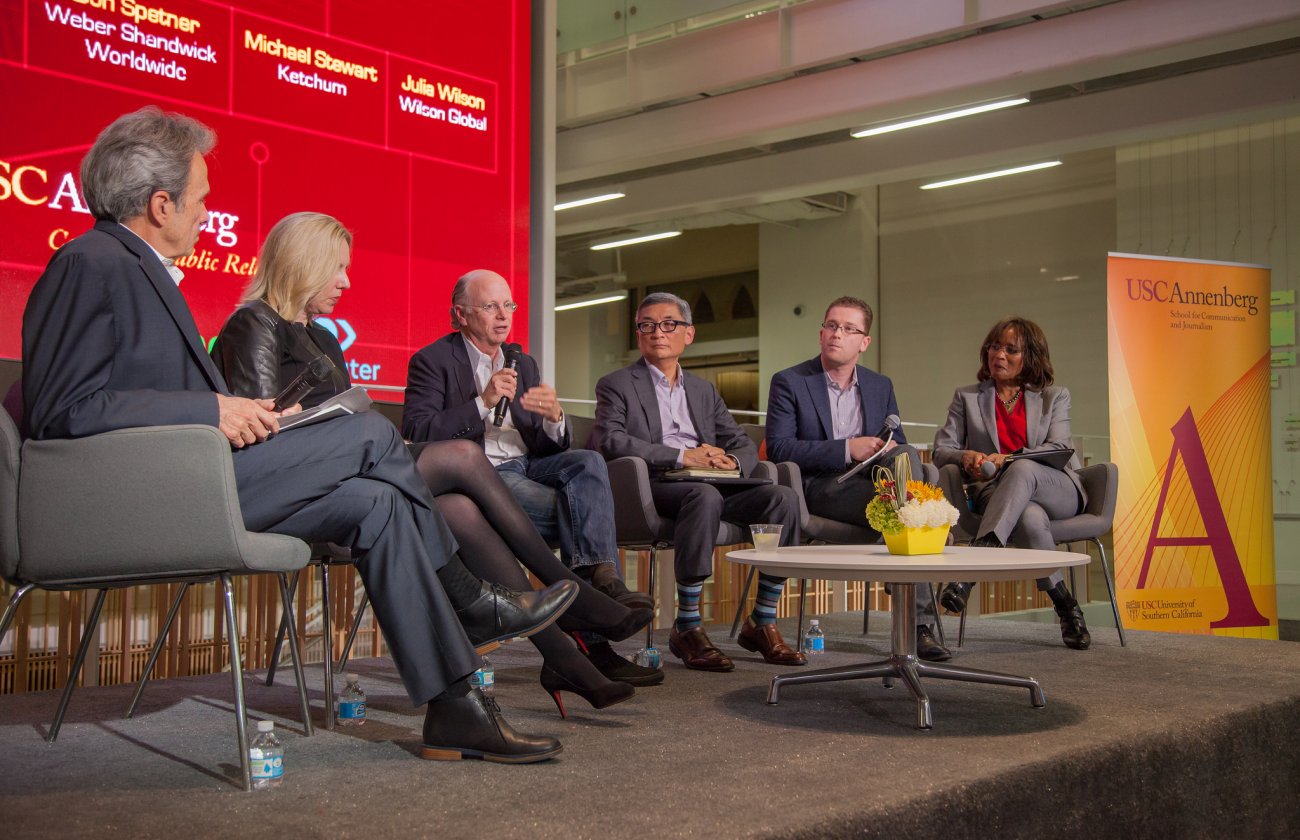Sundance Institute and Women In Film Los Angeles, co-founders of the Female Filmmakers Initiative, unveiled this week research from USC Annenberg’s Media, Diversity, & Social Change Initiative that uncovered a broken pipeline for female filmmakers when it comes to distributing deals and exhibition patterns.
The study first examines what happens to films by both male and female Sundance Film Festival U.S. Dramatic Competition directors. Then, qualitative interviews with filmmakers, film buyers and film sellers provide deeper insight into the issues facing female directors. Over 60 USC students worked on the study in the MDSC Initiative lab. ![]() The full report can be found here.
The full report can be found here.
“Female directors face a steep fiscal cliff as they attempt to move from independent to more commercial filmmaking. Across 1,300 top films from 2002 to 2014, the ratio of male to female directors was just over 23 to 1,” said Professor Stacy Smith, the Principal Investigator and Director of the Media, Diversity, & Social Change Initiative. “In this report, we identify the barriers that help explain this gender disparity. After three years of research, the question can progress from ‘why are female directors missing behind the camera in top films?’ to ‘what can be done to create change?’” “Having completed this three-year study, we have accomplished a thorough analysis of this issue and now know that female filmmakers face deep-rooted presumptions from the film industry about their creative qualifications, sensibilities, tendencies and ambitions. Now we need to move a heavy boat through deep waters, and WIF is committed to year-round action until sustainable gender parity is achieved,” said Cathy Schulman, President of Women In Film Los Angeles. Keri Putnam, Executive Director of Sundance Institute, said, “With three years of research to build upon, we’re at a watershed moment of awareness regarding gender inequality, and these new findings help pinpoint where and why female filmmakers fall out of the industry’s pipeline. Diversity in media is critically important to the health of our culture because it is through media that we understand ourselves and each other. We can’t make systemic shifts without allies in all corners of the industry.”
Quantitative Findings: Content, Distribution and Exhibition of Films in SFF U.S. Dramatic Competition 2002-2014
- Females directed one-quarter of the films in SFF U.S. Dramatic Competition between 2002 and 2014. Of the 208 U.S. Dramatic Competition films at SFF between 2002 and 2014, 25.5 percent had a female director (n=53) and 74.5 percent had a male director (n=155). This translates into a gender ratio of 2.9 to 1.
- Gender is a significant factor in the types of stories told by directors in SFF U.S. Dramatic Competition. Three-quarters of all SFF U.S. Dramatic Competition movies featured drama, comedy and/or romance, with female-directed films (92.5 percent) more concentrated in these genres than male-directed films (69 percent). Lead character gender was also associated with director gender. Male-directed films were more likely to feature male leads whereas female-directed films were more likely to feature female leads.
- Gender did not affect whether SFF U.S. Dramatic Competition films received theatrical distribution. Of the 208 SFF U.S. Dramatic Competition movies from 2002-2014, 177 received domestic distribution (85.1 percent) and 31 did not. Female-directed films (88.7 percent) were just as likely to receive distribution out of SFF U.S. Dramatic Competition as male-directed films (83.9 percent).
- There are differences in the types of companies that distribute male- and female-directed films. Movies with a female director (70.2%) were more likely than movies with a male director (56.9%) to be distributed by Independent companies with fewer financial resources and lower industry clout. Conversely, male-directed films (43.1%) were more likely than female-directed films (29.8%) to receive distribution from a Studio Specialty/Mini Major company—companies with deeper pockets and greater reach.
- Theatrical density was not related to director gender among SFF films with limited Independent distribution. Male-directed and female-directed SFF U.S. Dramatic Competition films with Independent distribution were equally likely to be shown in 1-75 theatres as to be shown in 76-250+ theatres.
- At the highest platform of theatrical distribution, above 250 screens, male directors outnumber female directors by a factor of 6 to 1. Among films distributed by Studio Specialty/Mini Major companies, a greater percentage of male-directed films (32.1 percent, n=18) were shown in 251+ theatres than female-directed films (21.4 percent, n=3).
- The director gender gap is at its widest in top-grossing films. Across 1,300 top-grossing films from 2002 to 2014, only 4.1 percent of all directors (n=59 of 1,433) were female. This calculates into a gender ratio of 23.3 male directors to every 1 female director.
- The prevalence of females decreases notably when moving from independent to mainstream film. In 2014, there was a 25 percent difference between the percentage of female directors at SFF (26.9 percent) and the percentage of female directors across the top 100 films (1.9 percent). This is almost double the gap observed in 2002.
- The results from this study demonstrate that female directors set out on a course that confirms and triggers a stereotype that may affect the deals they make and the opportunities they are offered. As such, the choices female directors make early in their careers can have lasting financial consequences.
Qualitative Findings: Impediments Facing Female Directors
- The qualitative section of the report uses data from 59 interviews (39 male, 20 female) with buyers and sellers who were asked about the reasons for the lack of female directors in top 100 films. Forty-one female directors were also interviewed. The major barriers that emerged were consistent with results from previous phases as well as other research. Those impediments were:
- Perception of a Gendered Marketplace (44 percent): Female directors are perceived to make films for a subset and/or less significant portion of the marketplace. In contrast, films by males are perceived to reach wide and lucrative segments of the market. One explanation for this difference is the tendency to “think director, think male,” or to describe the job of a director or profitable film content in masculine terms.
- Scarcity of Talent Pool and Experience (42 percent): Industry decision-makers perceive that there is a scarcity of female directors and a small pool to choose from in top-grossing films. Those interviewed named, on average, three female directors who might be included on consideration lists. In contrast, 45 different women helmed one of the 100 top-grossing movies across 13 years, and over 100 different women brought a narrative film to Sundance Film Festival from 2002 to 2014.
- Women’s Perceived Lack of Ambition (25 percent): Participants mentioned or questioned the degree of interest women have in 1) the directing position generally and 2) genre-based jobs, including action and tent-pole films. Sellers were more likely to report this impediment than buyers were. However, when asked directly about their ambitions, nearly half of female directors (43.9 percent) interviewed articulated an interest in larger-budget, action or blockbuster films.
- Industry Gender Imbalance (22 percent): Responses described the skewed representation of women in the film industry. This includes the predominance of men in gatekeeping positions and an industry socialization process and/or culture (e.g., boy’s club) that is male-dominated.
- Little Support and Few Opportunities (14 percent): Individuals mentioned or questioned whether agents and managers are putting women up for jobs and the scarcity of chances or opportunities given to women.
- Competence Doubted (12 percent): Participants mentioned or speculated about beliefs that women “can’t handle” certain types of films or aspects of production, such as commanding a large crew. When asked if their authority had been doubted, 70 percent of female directors interviewed answered that they had been challenged by a work colleague.










